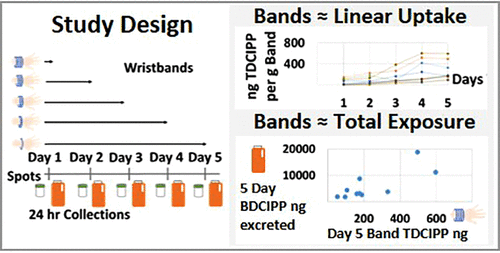当前位置:
X-MOL 学术
›
Environ. Sci. Technol. Lett.
›
论文详情
Our official English website, www.x-mol.net, welcomes your
feedback! (Note: you will need to create a separate account there.)
Monitoring Human Exposure to Organophosphate Esters: Comparing Silicone Wristbands with Spot Urine Samples as Predictors of Internal Dose
Environmental Science & Technology Letters ( IF 8.9 ) Pub Date : 2021-08-24 , DOI: 10.1021/acs.estlett.1c00629 Kate Hoffman 1 , Jessica L Levasseur 1 , Sharon Zhang 1 , Duncan Hay 1 , Nicholas J Herkert 1 , Heather M Stapleton 1
Environmental Science & Technology Letters ( IF 8.9 ) Pub Date : 2021-08-24 , DOI: 10.1021/acs.estlett.1c00629 Kate Hoffman 1 , Jessica L Levasseur 1 , Sharon Zhang 1 , Duncan Hay 1 , Nicholas J Herkert 1 , Heather M Stapleton 1
Affiliation

|
Silicone wristbands present a noninvasive exposure assessment tool and an alternative to traditional biomonitoring; however, questions about their utility remain as validation studies are limited. We sought to determine if wristbands provide quantitative estimates of internal organophosphate ester (OPE) exposure. We evaluated internal dose by measuring metabolite masses excreted in 24-h urine samples collected over five days among 10 adults. We compared internal dose to OPE concentrations in paired wristbands worn during collection and, as a comparison, evaluated metabolite levels in spot urine samples. Three of six OPE metabolites evaluated were detected in greater than 98% of urine samples, and 24 of 34 assessed OPEs were detected in at least one wristband. OPE uptake in wristbands was linear over time (range = 0.54–61.8 ng/g/day). OPE concentrations in spot urine and wristbands were not correlated with total diphenyl phosphate (DPHP) excreted in urine, which may be due to the range of possible DPHP parent compounds or dietary exposure. However, for tris(1,3-dichloro-2-propyl)phosphate (TDCIPP) and tris(2-chloroisopropyl)phosphate (TCIPP), wristbands and spot urine samples were both moderately to strongly correlated with internal dose (all rs > 0.56 and p < 0.1), suggesting both perform well as integrated exposure estimates. Given the potential advantages of silicone wristbands, further studies investigating additional compounds are warranted.
中文翻译:

监测人体对有机磷酸酯的暴露:将硅胶腕带与尿液样本作为内部剂量的预测指标进行比较
硅胶腕带是一种无创暴露评估工具,是传统生物监测的替代品;然而,由于验证研究有限,有关其效用的问题仍然存在。我们试图确定腕带是否提供内部有机磷酸酯 (OPE) 暴露的定量估计。我们通过测量 10 名成年人在 5 天内收集的 24 小时尿液样本中排泄的代谢物质量来评估内部剂量。我们将内部剂量与收集期间佩戴的配对腕带中的 OPE 浓度进行了比较,并作为比较评估了尿液样本中的代谢物水平。在超过 98% 的尿液样本中检测到评估的六种 OPE 代谢物中的三种,并且在至少一个腕带中检测到 34 种评估的 OPE 中的 24 种。腕带中的 OPE 摄取随时间呈线性变化(范围 = 0.54–61.8 ng/g/天)。点尿和腕带中的 OPE 浓度与尿液中排泄的总磷酸二苯酯 (DPHP) 无关,这可能是由于可能的 DPHP 母体化合物范围或饮食暴露所致。然而,对于三(1,3-二氯-2-丙基)磷酸盐 (TDCIPP) 和三(2-氯异丙基)磷酸盐 (TCIPP),腕带和点尿样本均与内剂量呈中度至强相关(所有r s > 0.56 和p < 0.1),表明两者在综合暴露估计中表现良好。鉴于硅胶腕带的潜在优势,有必要进一步研究调查其他化合物。
更新日期:2021-09-14
中文翻译:

监测人体对有机磷酸酯的暴露:将硅胶腕带与尿液样本作为内部剂量的预测指标进行比较
硅胶腕带是一种无创暴露评估工具,是传统生物监测的替代品;然而,由于验证研究有限,有关其效用的问题仍然存在。我们试图确定腕带是否提供内部有机磷酸酯 (OPE) 暴露的定量估计。我们通过测量 10 名成年人在 5 天内收集的 24 小时尿液样本中排泄的代谢物质量来评估内部剂量。我们将内部剂量与收集期间佩戴的配对腕带中的 OPE 浓度进行了比较,并作为比较评估了尿液样本中的代谢物水平。在超过 98% 的尿液样本中检测到评估的六种 OPE 代谢物中的三种,并且在至少一个腕带中检测到 34 种评估的 OPE 中的 24 种。腕带中的 OPE 摄取随时间呈线性变化(范围 = 0.54–61.8 ng/g/天)。点尿和腕带中的 OPE 浓度与尿液中排泄的总磷酸二苯酯 (DPHP) 无关,这可能是由于可能的 DPHP 母体化合物范围或饮食暴露所致。然而,对于三(1,3-二氯-2-丙基)磷酸盐 (TDCIPP) 和三(2-氯异丙基)磷酸盐 (TCIPP),腕带和点尿样本均与内剂量呈中度至强相关(所有r s > 0.56 和p < 0.1),表明两者在综合暴露估计中表现良好。鉴于硅胶腕带的潜在优势,有必要进一步研究调查其他化合物。











































 京公网安备 11010802027423号
京公网安备 11010802027423号